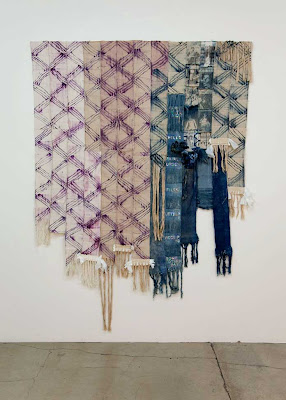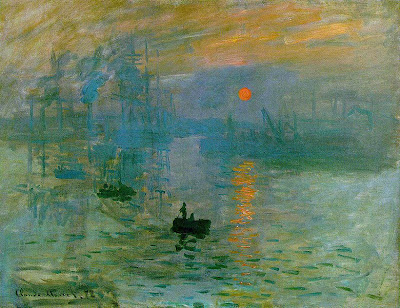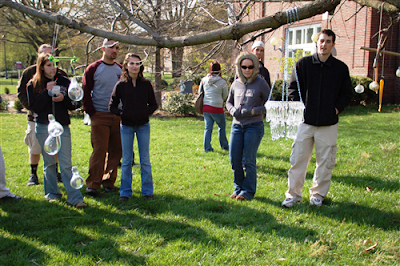>Nicolas Bell, Curator of the Smithsonian’s Renwick Gallery talked about the rise of “Sloppy Craft Movement” during his talk on influences of the 40 under 40 exhibit (currently on exhibit thru Feb 3rd 2013). This concept has been talked about in the Glass School for a while, as many of the artists here come from diverse backgrounds – often from outside the glass craft world… and it is a great subject that deserves more attention in the art blogdom world.
“Sloppy Craft” – is this an oxymoron? I thought that many may not understand the concept of sloppy craft, and a cynically-minded person, could view much of the work – often designed to maximize the shock value – as a transparent bid for attention in the contemporary art world, which has long made a point of embracing my-kid-could-do-that aesthetics.
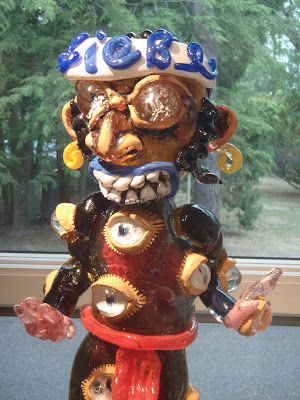 |
| Mixed Media/Glass sculpture by the De La Torre Brothers Einar and Jamex De La Torre derive their gutsy imagery from such diverse influences as Jose Posada, television, the Vatican and the darling of modern comics, the huge eyed Anime characters. |
In 2009, Glen Adamson, the Deputy Director of Research at the Victoria and Albert Museum coined the phrase “Sloppy Craft” which he defined it as “the unkempt product of a post-disciplinary craft education.”
The origins of “Post Disciplinary Craft” begin in the early 2000’s when new ways of thinking about craft began to form and many saw a need for a more relevant understanding of current craft practice and objects. The earlier models of understanding craft, which relied on either the Arts and Crafts Movement or the Back to the Land counterculture movement that had influenced studio craft in the 1960s and 1970s, would have to be replaced.
The youngsters of craft no longer felt connected to the past – or rather, are not referencing the history of the mediums – that is not their focus. They didn’t learn in apprenticeships with masters and a growing number had abandoned classrooms. They weren’t wed to techniques or materials. University art programs found that the students did not want to be categorized as “glass artists” or “clay artists” and, as the students just want the media skills as part of their repertoire, sought to merge curriculums under the term “Material Studies”. Young crafters also learned from other sources – such as their peers or the Internet. The digital age would be to craft what the sexual revolution was to feminism. This is an approach to craft that resonates with the times, linking craft to the wider concerns of today’s society (ie: think global,act local; feminism; gender politics; social justice and ecological concerns). The don’t be precious DYI movementresponse of current craft students were a couple of other aspects of “sloppy craft.” One was the recycling of materials — found or “trash” art, one might call it. It’s everywhere these days, certainly if you looked at the works at DC’s semi-annual artfest Artomatic – and no one bats an eye at the exhibits. The other aspect of this kind of casual crafting is that it appears most often in assemblages and collage. Assemblages and collage have clear ancestors, dating back to Picasso through Rauschenberg and are seen and made by thousands of people who may not even think of themselves as artists.
Traditionally, a craftsperson would spend years polishing their craft, working at the highest level until one was so good that one could let it go – forgetting technique and working from the heart intuitively; the crafter/artist would have behind them all the knowledge needed to return to “fineness” if the artwork required it.
To some extent Josh Faught fits that mold. He self-identified as a Fibers Major at the Art Institute of
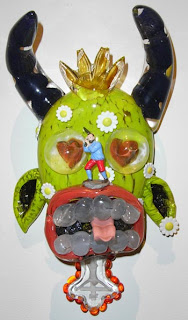 |
| Einar and Jamex de la Torre |
But making things, it turns out, is still quite difficult. Indeed, the one thing that seems to bind the majority of contemporary art together is the lack of skill required to create it. Glen Adamson also explored the popular notion of what defines “craft” and why some may think that craft always has to be finely made. He states,” On the one hand, skill commands respect. We value the integrity of the well-made object, the time and care it demands. Therefore, what we most want out of our craft is something like perfection. On the other hand, though, we value craft’s irregularity– it’s human, indeed humane, character. We want craft to stand in opposition to the slick and soulless products of systematized industrial production.” With this in mind many people would want to consider something very well made to be craft and not something considered to be sloppy craft.
What about the name of the movement – “sloppy craft”? “Sloppy” is really a sound bite kind of name, irresistible once spoken out loud. The reference was used extensively with textile and fabric art, but examples can be found in all the crafts. “Sloppy” indicates intentionality, which might not be the case with the art. “Sloppy Craft” is an unfortunate phrase — perhaps other names like “informal” “casual” or “raw” would be less jarring than “sloppy” to describe contemporary art that has some base in traditional crafts.
Artists need to examine these historical approaches and goals –whether it is humility, authenticity, expressiveness, shock value and impact – to see if they are useful in understanding and contextualizing sloppy and post-disciplinary craft. At the very least, it will help demonstrate whether contemporary craft is an evolution (of its prior forms) or a revolution.
Looking for Artist Space in the DC Area?! CAN -do!
>
 |
| The Washington School of Photography |
 |
| Capitol Arts Network – CAN Studios |
Two DC Area nonprofits The Washington School of Photography and Capitol Arts Network (CAN Studios) have teamed up to show that in unity, there is strength.
Together they are creating an arts center and a photography center in a 25,000 square foot building, with gallery openings, classes and more. They plan on having the building open 70 hours a week, every day of the week, with classes…and with free parking!
 |
| 12276 Wilkins Avenue in Rockville, MD |
The photography center will have six classrooms, three shooting studios, a gallery, public darkroom, conference rooms, and an office/studio rental program for photographers. The arts center in the same building will be offering artists’ studios and space for affiliate artists to work. Their goal is to have classes ranging from running an art business to networking and new processes – with a gallery, meeting rooms, classrooms, and space for all sorts of arts groups to meet with synergy, activity, and interaction.
Two informational meetings are scheduled at the Washington School of Photography for artists and photographers interested in resident artist or photographer opportunities either with the Washington School of Photography or Capitol Arts Network – CAN Studios.
September 5th from 7 pm -9 pm
September 8th from 11 am -1 pm
Information Meeting Location: Washington School of Photography
4850 Rugby Avenue
Bethesda, MD 20814
301-654-1998
Come to one of these meetings and they will be showing their floor plans and photographs of the building, with an information packet, application, and overview of both groups and collective vision. With studio space for approximately 30 artists, and 10 photographers, it is expect to fill quickly, so plan to attend one of these informational meetings.
RSVP:
*Email Judith HeartSong at judith@capitolartsnetwork.com by September 4, 2012 to attend.
If you have questions, please call Judith HeartSong at 301-661-7590.
Capitol Arts Network
PLEASE Pass this information along to your artist and photographer friends
2012 Taos Art Glass Invitational Features Erwin Timmers
>
In its fourth year, the Taos Art Glass Invitational makes New Mexico a prime destination that attracts artists, collectors and visitors from all around the world.
Friday September 14, 2012 at 2:00 PM through Sunday October 7, 2012
This year’s event includes multiple exhibitions, lectures, demonstrations and experiences that are collectively titled “Taos Celebrates Contemporary Glass: Fifty Years of Art Innovation”. The lead exhibition is the Taos Art Glass Invitational, a juried exhibition featuring the best in contemporary studio glass today.
The series of exhibitions, self-guided tours and educational events celebrates the unique contribution of the American Studio Glass Movement to the field of contemporary art.
Erwin Timmers’ artwork will be featured at Wilder Nightingale Fine Art, 119-A Kit Carson Road, Taos, New Mexico
Other special events include “Light up the Night,” September 28, from 7-10 p.m. when Taos Plaza will be lit with glassblowers at work. On Thursday, September 27, a live installation art project called “Recycling Light” will be created at Taos Institute for Glass Arts. A Collectors’ Tour will be held September 20-23. This celebration of glass is produced by TIGA (Taos Institute for Glass Arts).
Sean Hennessey Constructing Art
>
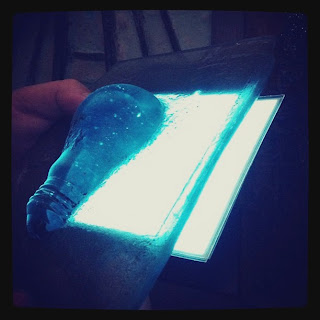 |
| Sean Hennessey often incorporates electronics into his cast glass works. Here he is testing new el-wire (electroluminescent) sheet for his panels. |
Artist Sean Hennessey is in da house! (Or at least da Studio!) working on a new series of cast glass/mixed media panels. Fresh from his successful show at Blue Spiral Gallery in Asheville and Artomatic, Sean continues to move forward in his artwork. Sean is kilncasting slabs of glass for his upcoming shows, including “Constructing Content” with fellow Washington Glass artists Erwin Timmers and Erin Antognoli that opens Dec 1 at the Kline Gallery in Frederick, MD’s Delaplaine Arts Center.
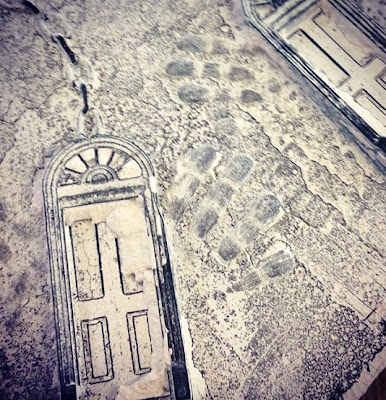 |
| Opening the kiln, Sean removes the plaster from cast glass. |
| Sean’s glass is formed using dry-plaster casting technique captures the detail of his fingerprints. |
Constructing Content
An exhibit featuring Washington Glass School sculptors Erwin Timmers, Sean Hennessey, and Erin Antognoli. The mixed media sculptors combine photography, steel and glass. More will be published online soon!
| Sean appraises the composition of panel after annealing. |
December 1–30, 2012
Kline Gallery
40 South Carroll Street
Frederick, Maryland 21701
Georgetown Book Hill Gallery Walk features WGS artists
>
On September 14 from 6-8pm, DC’s Georgetown will have an evening Gallery Walk that will showcase art galleries located on the upper Wisconsin Ave – near Book Hill Park.
 |
| Allegra Marquart “Peacock’s Compliant” |
Maurine Littleton Gallery will feature artwork by local DC-area artists including Allegra Marquart, Michael Janis and Drew Storm Graham at the gallery for the September 14 Book Hill gallery walk event.
 |
| Drew Storm Graham “Dusk” |
 |
| Michael Janis “Eclipse” |
September 14 from 6-8pm
phone: 202-333-9307
Marc Petrovic Solo Show @ Heller Gallery
>
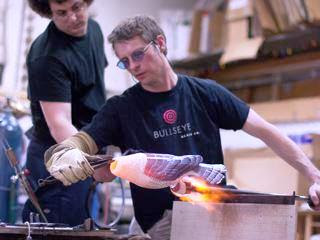 |
| Marc Petrovic with Jonathan Chapman work in the hot shop to shape the glass into a dimensional piece. |
Using Bullseyecolored glass, Marc cuts the sheet glass, arranges and fuses it into abstract patterned slabs (beautiful as an abstract flat plate). He then uses the “Aussie Roll-up” technique to transform them into incredibly detailed blown glass sculptures. If you are familiar with Marc’s work, his knowledge of anatomy of (seemingly all) living creatures comes into play, as his work easily travels between obsessive, meditative labor, visionary abstraction and poignant representation. He has been working on this show for most of the past year, and it really shows in the beauty and detail of the work.
 |
| Marc Petrovic “Avian” Hot-sculpted and blown Bullseye murrini roll-up. H 9, W 15, D 10 in. |
MARC PETROVIC – AVIAN
September 7- October 6, 2012
Reception for the artist: Thursday, September 6, 6-8pm
Demo: Saturday, September 8, 2012 11am at Brooklyn Glass to benefit Urban Glass Studio.
Debra Ruzinsky Solo Show at VisArts Gallery
>
 |
| Debra Ruzinsky at her show opening at the Brattleboro Museum. Images of Deb’s work are also featured in the book ” New Technologies in Glass“, by Dr. Vanessa Cutler. |
Debra Ruzinsky – one of the DC area Master Casters, has a solo show at Rockville’s VisArts Center set to open September 14, and run thru October 20th, 2012. Deb’s artwork that was featured in the Long View Gallery 2011 exhibit of artists of the Washington Glass School had the critic for the Washington Post question his previously held beliefs on what contemporary art should look like, as he stood in front of her work “Staring at it [Debra Ruzinsky’s cast glass], I feel like a monkey in front of a ball of shiny, shiny tin foil.” By Michael O’Sullivan, Washington Post, Thursday, May 26, 2011
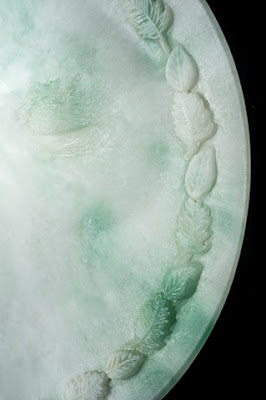 |
|
“Sight”, 2012, kiln cast glass
8” x 8” x 8″
|
Debra works in kiln-cast glass and mixed-media, producing objects that mix distopian and utopian visions, investigating belief and meaning. Her new series that takes an oblique look at objects imbued with personal meanings. Referencing memorabilia, collectibles, and luxury goods for display, these objects form a fragmented portraiture, with discrete elements creating implications of a whole.
 |
|
“Detached” , 2012, kiln-cast glass and mixed media
7”h x 24”w x 1-3/4”d
|
Portions
Solo show, opens September 14
at VisArts – Common Ground Gallery.http://www.visartsatrockville.org/exhibi
VisArts
155 Gibbs Street, Rockville, MD 20850
Not Just Another Stained Glass Piece
>
There are over 30,000 works of art are at the museum, and many spend time in storage.The Picasso wouldn’t have been there so long if the museum would have known it was a Picasso to begin with. Museum officials say it was cataloged as art inspired by a design for a Picasso painting but credited to an artist named Gemmaux. That name turned out to be plural for “gemmail,” which is the type of glass used in the work.
“When the piece came in, the documents associated with the gift indicated it was by an artist named ‘Gemmaux’, and it was from a design inspired by a Picasso oil painting,” said museum curator Mary Bower.
It wasn’t until this past February, when a
Picasso discovered the Gemmail in 1954 through Jean Cocteau at the Malherbe art studio. Fascinated by the light, the material and the transparency, Picasso contemplated the offer to illuminate all his master pieces. He made his first Gemmail art work “Femme dans un fauteuild’osier” in 1954.
Picasso shared his discovery and his creations with George Braque. The two artists had tried to introduce volume and a new perception of shapes through cubism. Braque who was always looking for new artistic techniques and materials was won over by the Gemmail and created several works himself. He stated : ” If I were thirty years old, I would be known as the Gemmist Braque.”
The
“In the history of our museum, this is the most important moment,” said museum director John Streetman. “This is the biggest thing that’s happened to the museum or probably will happen to the museum. It’s enormous.”
Enormous is also a way to describe the price tag that museum officials say would come with keeping the art safe it if was put on display.
“The value of the piece makes it prohibitive for us to insure it. Then we would have all sorts of considerations about staffing all sorts of electronic additions, to what we do with our facility that just makes it impossible to keep, and we’re so sad about that,” Streetman said.
Glass Artist Dave D’Orio Trawick Prize Finalist
>Dave D’Orio, (owner of our sister glass school, hot shop DC GlassWorks), was named as one of the eight finalists for this year’s prestigious Trawick Prize.
| The website for the Trawick uses one of Dave’s works as its banner headline. |
The 2012 exhibition will be held in September at Gallery B, located at 7700 Wisconsin Avenue, Suite E, Bethesda, MD 20814. Winners will be announced September 5.
Selected finalists will have their work on display September 1 – 29, 2012 in downtown Bethesda at Gallery B, located at 7700 Wisconsin Avenue, Suite E.The Gallery is located just two blocks from the Bethesda Metro station.
The opening reception for The Trawick Prize will take place Friday, September 14 from 6-9pm, in conjunction with the Bethesda Art Walk. Many of the finalists and winners will be on hand to discuss their work.
Congratulations Dave!
Salisbury University Seeks Assist Prof of Art, Glass
>
Assistant Professor of Art, Glass – Faculty Position (10881)
- Current Active SU Employees, please login to GullNet and click “Careers at SU.”
- All others, please click Apply Online.
- See OEAS FAQs (Online Employment Application System FAQs) for help.
| SU’s hot glass workshop, where students learn the art of glassblowing, the only such program in the state of Maryland |
Area of Specialization: Hot Glass and 3D Studio
Primary Job Duties: Teaching three hot glass classes per semester with a total of 18 contact hours of teaching per week. Maintain studio, build and maintain equipment in glass, and implement and adhere to safety protocols. Program development for glass, active recruitment of majors, advisement, and departmental committee work are required. Utilize effective teaching and classroom management strategies which enhance the success of diverse learners.
Minimum Qualifications: MFA with an emphasis in hot glass. Preference will be given for prior teaching experience and an active exhibition record.
Applications will be accepted via Salisbury University’s Online Employment Application System. Please visit our website http://www.salisbury.edu/HR/Jobs/ to apply online. See the FAQs of the Online Employment Application System for more information and instructions.
To be considered an applicant, you must apply online and submit the following: letter of application, CV, two sample syllabi and a statement of teaching philosophy, exhibition record, graduate and undergraduate transcripts (copies accepted), and the names and contact information of at least five (5) professional references. All other documents that you wish to provide must be attached to your application in the Online Employment Application System. Please do not send any other documents via E-mail. If you have any questions about the position, please contact the Jim Hill, at jkhill@salisbury.edu.
Note: Mail CD containing 20 digital images of applicant artwork, and 20 images of student work with size, dates and media of each piece identified. To the Attention: Salisbury University, Art Department, M K Brown, 1101 Camden Avenue, Salisbury, MD 21801.
Applications submitted by October 22, 2012 will receive first consideration. The position will remain open until filled. Salary is competitive and commensurate with qualifications and experience. Appointment will be contingent upon verification of eligibility to work in the U.S. and is expected to begin August 15, 2013.
This position is based in Salisbury Maryland. Founded in 1925, Salisbury University is one of 13 institutions that compose the University System of Maryland. Salisbury University is a selective undergraduate institution with the University System of Maryland. The Art Department is a vibrant, fast-growing, collegial department with a full-time faculty of 18 artists and one full-time art historian, with possibly a second tenure-track position in Art History in the near future. The University is close to ocean beaches and the Chesapeake Bay and 2-3 hours from the metropolitan areas of Washington, Baltimore, Philadelphia, and Norfolk. SU has been cited nationally as one of the top ten public regional universities in the North according to the U.S. News and World Report, and has also been recognized by the Princeton Review and Kiplingers magazine. SU has 388 full-time faculty members serving a student population of approximately 8,600.
For more information – click HERE to jump to University Job Listing
